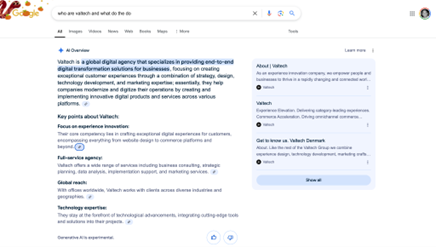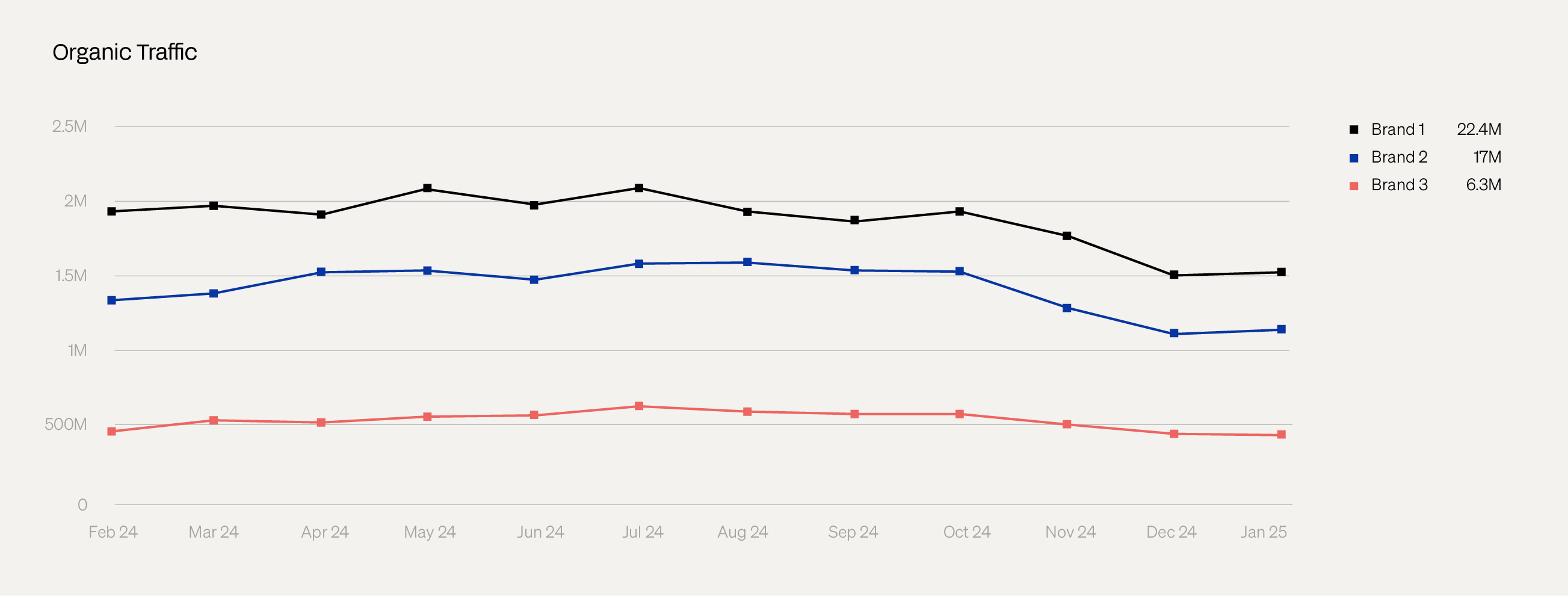février 18, 2025
In October 2024 Google blew up search. The interface was changed to include AI Overview summarizing content from a range of sources. As a result, website traffic is in decline (over 20% for three of our top manufacturing clients researched).
The marketing playbook has been turned on its head and this means you need to rethink how you measure success, communicate with your stakeholders and the role of your website.
This blog breaks down the changes we are seeing in the market and what you need to do to fix it.
What is the role of the website for B2B brands or Manufacturers?
Before we talk about the changes Google has made it is important to ask the question: Why do B2B organizations or manufacturers have a website? Well, typically the role of the website in B2B or manufacturing is as a relationship builder. A strategic tool that can used in various ways:
-
To help you connect with audiences. This is especially important when growing into new markets or launching new products for new audience segments.
-
Brand differentiation - a key tool to stand out and differentiate in the market (from the sea of sameness) to build distinction and mental availability.
-
As a valuable tool to capture data and insights to inform the business and sales teams.
-
To capture quality marketing qualified leads for sales teams.
Your website is a key enabler to become a Connected Manufacturer.
What was the B2B marketing blueprint?
Go back a year or so to a simpler time. There was a marketing blueprint with the website at the heart.
Invest in thought leadership and content (that supports buyers across the buying journey) and publish it on your website. By building hubs of content (focused on keywords you are targeting) with a strong domain authority, the share of organic SEO traffic would grow.
This was a key tactic in building traffic and supporting prospects who were in the problem-solution identification phases. A way to connect with audiences and an opportunity to capture leads and nurture.
What changes did Google make to search?
In October 2024, Google made huge changes to its search experience by introducing AI Overview.
Using AI (Gemini) it now provides a description of the topic and succinct answers. The aim is to keep the user in the Google interface and provide the results they need without needing to visit another website.
This is especially valuable when audiences are in the early stage of solution product discovery and looking for (upper funnel content) information about a brand or a solution e.g. “Do xxx have any case studies in USA?” - “What is the 5G solution for the financial services industry?”

The rise of conversational AI
The changes with Google are coupled with the growth in the usage of ChatGPT and Gemini as sources for research.
In December 2023, Chat GPT was ranked 20th in referrals to our top five manufacturers in Europe. And one year later, in December 2024, it was the 2nd highest referral! (source: Similarweb).
Chat GPT is being used as a key tool in the buying journey for answering questions. It is key to make sure your brand is a source of reference.
What impact are these changes having
As a result of these changes, organic traffic for the big three manufacturers in Europe has dropped by over 22% (in 3 months). A trend I expect to continue going forward.

Source: Similarweb, Organic Search Traffic, Feb 2024-January 2025
As more content is served in Gemini and Chat GPT, less people are coming to websites and it means there is less opportunity to drive brand preference, capture data and leads for the business as a result.
5 things you should you do if your B2B website traffic is in decline
If you are seeing traffic for your B2B or manufacturing website decline, then there are five things you need to do:
-
Differentiated experience — It’s not good enough to have a website that just provides a utility. Information that can be sourced elsewhere. It needs to be a source of value to your customers or prospects, solving their problems, whilst staying true to your brand.
-
Data and measurement — Rethink what good looks like for KPIs and metrics and re-educate the business on the data that matters beyond visits. Look beyond traditional analytics. Connect website to CRM-data to understand how the website is being used to build relationships, implement surveys to measure customer satisfaction. Be clear on measuring the value the website is generating.
-
SEO — Ensure your content is a source of reference in AI-driven search. Design content for the audiences and their needs at every stage of the journey. Follow SEO best practices and ensure you are a voice of authority and a source of reference that is linked to. Leverage your own first party data. Focus on building intent-based content to capture traffic that is more likely to convert.
-
Conversational search — Probably the most unloved feature on your website. It is no longer good enough to have site search that does not work. This is where your audience is turning to ask questions. They expect answers and support. Fix your site search and explore how this can support you in building a differentiated experience.
-
Ecosystem strategy — The role of your website has changed. You need to define it and rethink your ecosystem strategy. What other channels will you invest in to reach audiences? What is their role and how will you connect and measure them? As organic traffic is in decline, owned first party data will become even more valuable. Don’t waste it with meaningless nurture flows and content that doesn’t connect. Invest in quality content to support these audiences.
If you own a B2B or manufacturing website and are seeing a decline in traffic, get in touch for a diagnostic and practical steps on how to become a Connected Manufacturer.
Mike Maxwell, Strategy Partner, Industrials Strategy Lead











